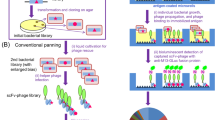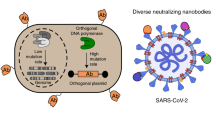Abstract
The immune response generates a tremendous array of antibody specificities by VDJ–gene rearrangements. A similar diversity can be obtained by expressing entire V–gene repertoires on the surface of filamentous bacteriophages creating large antibody libraries. Here we describe how the clonal selection mechanisms of the humoral immune resonse can also be mimicked in the phage display system by linking antigen–recognition and phage replication. We have achieved this by displaying antibody libraries on engineered, non–infectious phage with gene 3 deletions. Individual, antigen–specific phage are made replication competent by allowing a fusion protein, consisting of the antigen and phage coat protein 3, to bind the displayed antibody fragment. This fusion protein bridges the phage and F–pili of the bacteria and allows infection to be initiated and the phage to be clonally amplified with specific enrichment factors of approximately 1010 after only two rounds.
This is a preview of subscription content, access via your institution
Access options
Subscribe to this journal
Receive 12 print issues and online access
$209.00 per year
only $17.42 per issue
Buy this article
- Purchase on Springer Link
- Instant access to full article PDF
Prices may be subject to local taxes which are calculated during checkout
Similar content being viewed by others
References
Burnett, F.M. 1959. The Clonal Selection Theory of Immunity. Cambridge Univ. Press, UK.
McCafferty, J., Griffiths, A.D., Winter, G. and Chiswell, J. 1990. Phage antibodies: filamentous phage displaying antibody variable domains. Nature 348: 552–554.
Chang, C.N., Landolfi, N.F. and Queen, C. 1991. Expression of antibody Fab domains on bacteriophage surfaces. Potential use for antibody selection. J.Immunol. 147: 1065–3614.
Barbas, C.F. III, Kang, A.S., Lerner, R.A. and Benkovic, S.J. 1991. Assembly of combinatorial antibody libraries on phage surfaces. Proc. Natl. Acad. Sci. USA 88: 7978–7982.
Marks, J.D., Hoogenboom, H.R., Bonnert, T.P., McCafferty, J., Griffiths, A.D. and Winter, G. 1991. By-passing immunization. Human antibodies from V-gene libraries displayed on phage. J. Mol. Biol. 222: 581–597.
Waterhouse, P., Griffiths, A.D., Johnson, K.S. and Winter, G. 1993. Combinatorial infection and in vivo recombination: A strategy for making large phage antibody repertoire. Nucleic Acid Res. 21: 2265–2266.
Söderlind, E., Simonsson-Lagerkvist, A.C., Dueñas, M., Malmborg, A.C., Ayala, M., Danielsson, L. and Borrebaeck, C.A.K. 1993. Chaperonin-assisted phage display of antibody fragments on filamentous bacteriphages. Bio/Technology 11: 503–507.
Crissman, J.W. and Smith, G.P. 1984. Gene III protein of filamentous phages: Evidence for a carboxyl terminal domain with a role in morphogenesis. Virology 132: 445–455.
Boeke, J.D., Model, P. and Zinder, N.D. 1982. Effect of bacteriophage f1 gene III protein on the host cell membrane. Mol. Gen. Genet. 186: 185–192.
Dueñas, M., Chin, L.-T., Malmborg, A.-C. and Borrebaeck, C.A.K. 1994. Phage displayed antibodies derived from primary and secondary in vitro immunizations show affinity maturation. (Submitted)
Barbas, C.F. III, Bain, J.D., Hoekstra, D.M. and Lerner, R.A. 1992. Semisynthetic combinatorial antibody libraries: A chemical solution to the diversity problem. Proc. Natl. Acad. Sci. USA 89: 4457–4461.
Viera, J. and Messing, J. 1987. Production of single strand plasmid DNA. 1987. Meth. Enzymol. 153: 3–11.
Wezenbeek, P.M.G.F., Huselbos, T.J.M. and Schoenmarkers, G.G. 1980. Nucleotide sequence of filamentous bacteriophage M13 DNA genome: comparison with phage fd. Gene 11: 129–148.
Hoogenboom, H.R., Griffims, A.D., Johnson, K.S., Chiswell, D.J., Hudson, P. and Winter, G. 1991. Multi-subunit proteins on the surface of filamentous phage: Methodologies for displaying antibody (Fab) heavy and light chains. Nucleic Acid. Res. 19: 4133–4137.
Pfeifer, J.D., Wick, M.-J., Russell, D.G., Normark, S.J. and Harding, C.V. 1992. Recombinant Escherichia coli express a defined, cytoplasmic epitope that is efficiently processed in macrophage phagolysosomes for class II MHC presentation to T lymphocytes. J. Immunol. 148: 2578–2584.
Dueñas, M., Vazquez, J., Ayala, M., Söderlind, E., Ohlin, M., Perez, L., Borrebaeck, C.A.K. and Gavilondo, J.V. 1994. Intra-and extracellular expression of a scFv antibody fragment in E. coli: Effect of bacterial strains and pathway engineering using GroES/L chaperonins. Biotechniques 16: 476–483.
Porter, H. 1993. Application of electroporation in recombinant DNA technolohnology. Meth. Enzymol. 217: 461–478.
Garrard, L.J., Yang, M., O'Connell, M.P., Kelley, R.F. and Henner, D.J. 1991. Fab assembly and enrichment in a monovalent phage display system. Bio/Technology 9: 1373–1377.
Author information
Authors and Affiliations
Corresponding author
Rights and permissions
About this article
Cite this article
Dueñas, M., Borrebaeck, C. Clonal Selection and Amplification of Phage Displayed Antibodies by Linking Antigen Recognition and Phage Replication. Nat Biotechnol 12, 999–1002 (1994). https://doi.org/10.1038/nbt1094-999
Received:
Accepted:
Issue Date:
DOI: https://doi.org/10.1038/nbt1094-999
This article is cited by
-
Phage display systems and their applications
Applied Microbiology and Biotechnology (2006)
-
Selectively infective phage (SIP) technology: A novel method for in vivo selection of interacting protein–ligand pairs
Nature Medicine (1997)
-
Selection of proteins and peptides from libraries displayed on filamentous bacteriophage
Molecular Biotechnology (1996)



